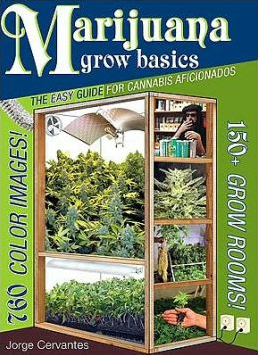
by Jorge Cervantes
Hydroponic Systems
Passive hydroponic systems rely on capillary action to transfer the nutrient solution “passively” from the reservoir to the growing medium. The Dutch are masters of passive systems and achieve amazing results. Wick systems have no moving parts. Low initial cost and low maintenance enhance wick systems’ popularity.
Active hydroponic systems “actively” move the nutrient solution, which is usually recovered. Cannabis is a fast-growing plant and very well suited to active hydroponic systems.
Ebb and flow (flood and drain) hydroponic systems are low maintenance and easy to use. Individual plants in pots or rockwool cubes are set on a special growing bed table that can hold 1-4 inches of nutrient solution. Nutrient solution is pumped into the table or growing bed. The rockwool blocs or containers are flooded from the bottom, which pushes the oxygen-poor air out. Once the nutrient solution reaches a set level, and overflow pipe drains the excess to the reservoir. Ebb and flow systems are ideal for growing many short plants in a Sea of Green garden. A Sea of Green garden is comprised of short females growing closely together, imitating a sea of green. Any garden with plants grouped closely together can be considered a sea of green.
In deep water culture (DWC), seedlings and clones are held in net pots full of expanded clay pellets, rockwool, or other growing mediums. These pots are nestled in holes in a lid that covers the reservoir. Roots dangle into the nutrient solution. A submersible pump lifts nutrient solution to where it splashes into the access lid wetting roots. Roots easily absorb nutrients and water from the solution in the oxygenated environment. An air stone pumps in more bubbles of xygen. Gardens are low maintenance and simple by design, and require no timer because the pumps are on 24 hours a day.
Top-feed hydroponic systems meter nutrient solution in specific doses via spaghetti tubing or an emitter placed at the base of individual plants. Aerated nutrient solution flows into the growing medium and is taken up by roots. The runoff nutrient solution is directed back to the reservoir as soon as it drains from the growing medium.
Top-feed systems come in many configurations. Systems with several gallons of growing medium are best for growing large plants that may require support. Small containers are perfect for smaller plants.
Rockwool, gravel, coconut cir, and expanded clay are the most common growing mediums found in top-feed systems. Versatile top-feed systems can be used with individual containers or slabs in individual beds or lined up on tables.
Nutrient film technique (NFT) hydroponic systems are high-performance gardens when fine-tuned. Aerated nutrient solution flows to roots located in gulleys. Seedlings or cuttings with a strong root system are placed on capillary matting located on the bottom in a covered channel. The capillary matting stabilizes nutrient solution flow and holds roots in place. Constantly aerated nutrient solution flows down the channel or gully, over and around the rots and back to the reservoir. irrigation is most often constant, 24 hours a day. Roots receive plenty of oxygen and are able t absorb a maximum of nutrient solution. Proper gulley incline, volume, and flow of nutrient solution are key elements in NFT gardens.
Aeroponic systems use no growing medium and offer the highest performance possible. Roots are suspended in a dark growth chamber with no growing medium. Roots are misted with oxygen-rich nutrient solution at regular intervals. The humidity in the chamber remains at or near 100 percent 24 hours a day. Roots have the maximum potential to absorb nutrient in the presence of air.

